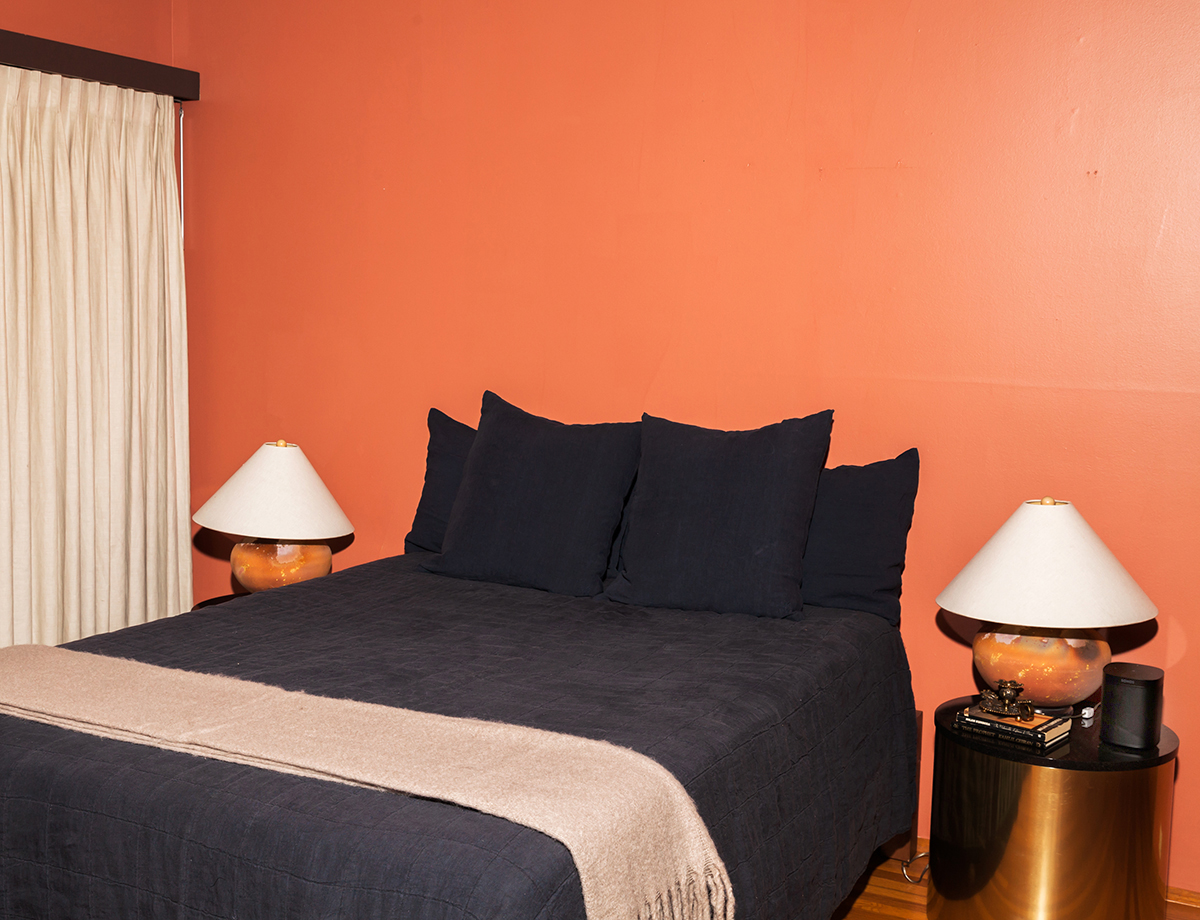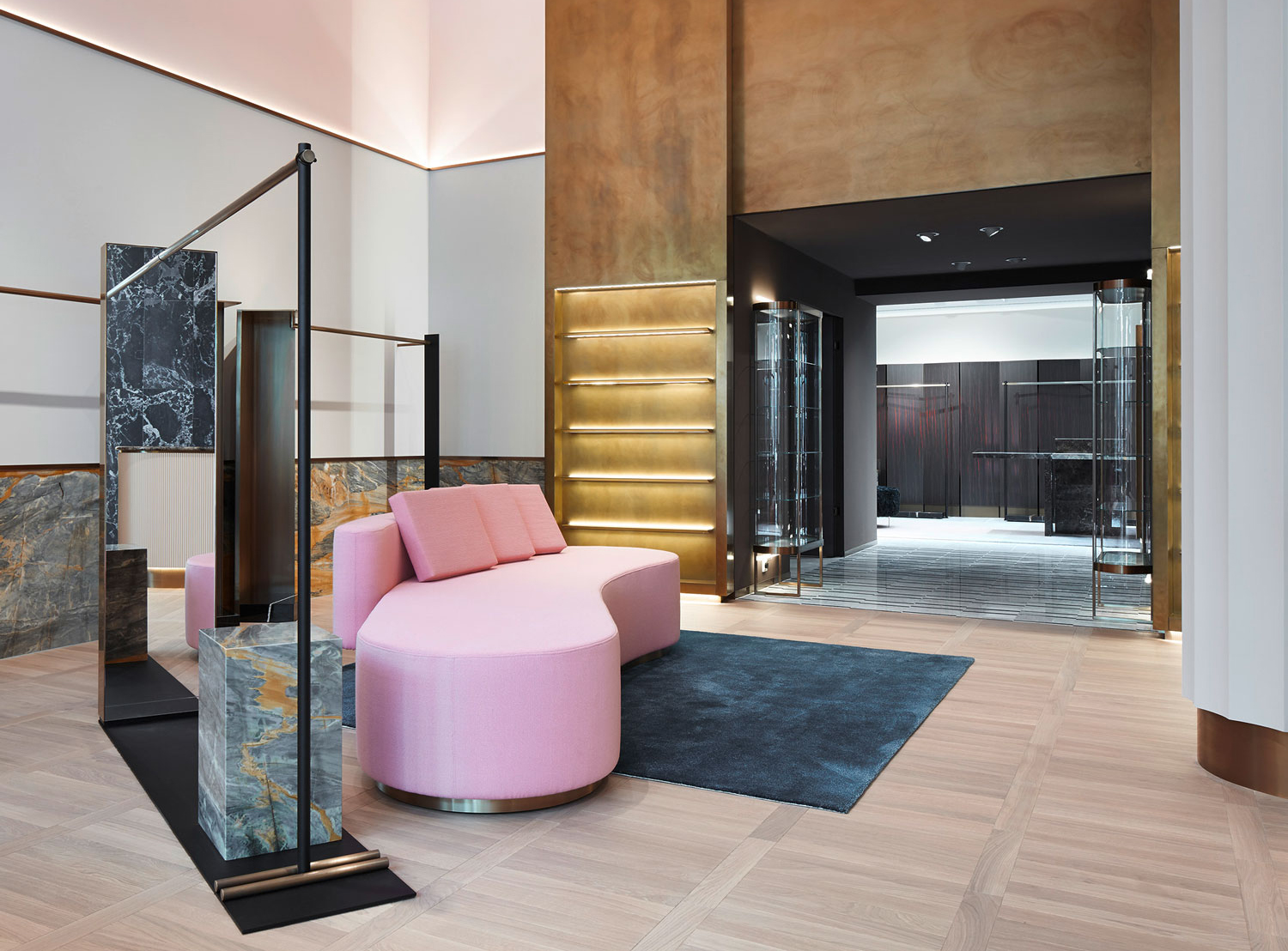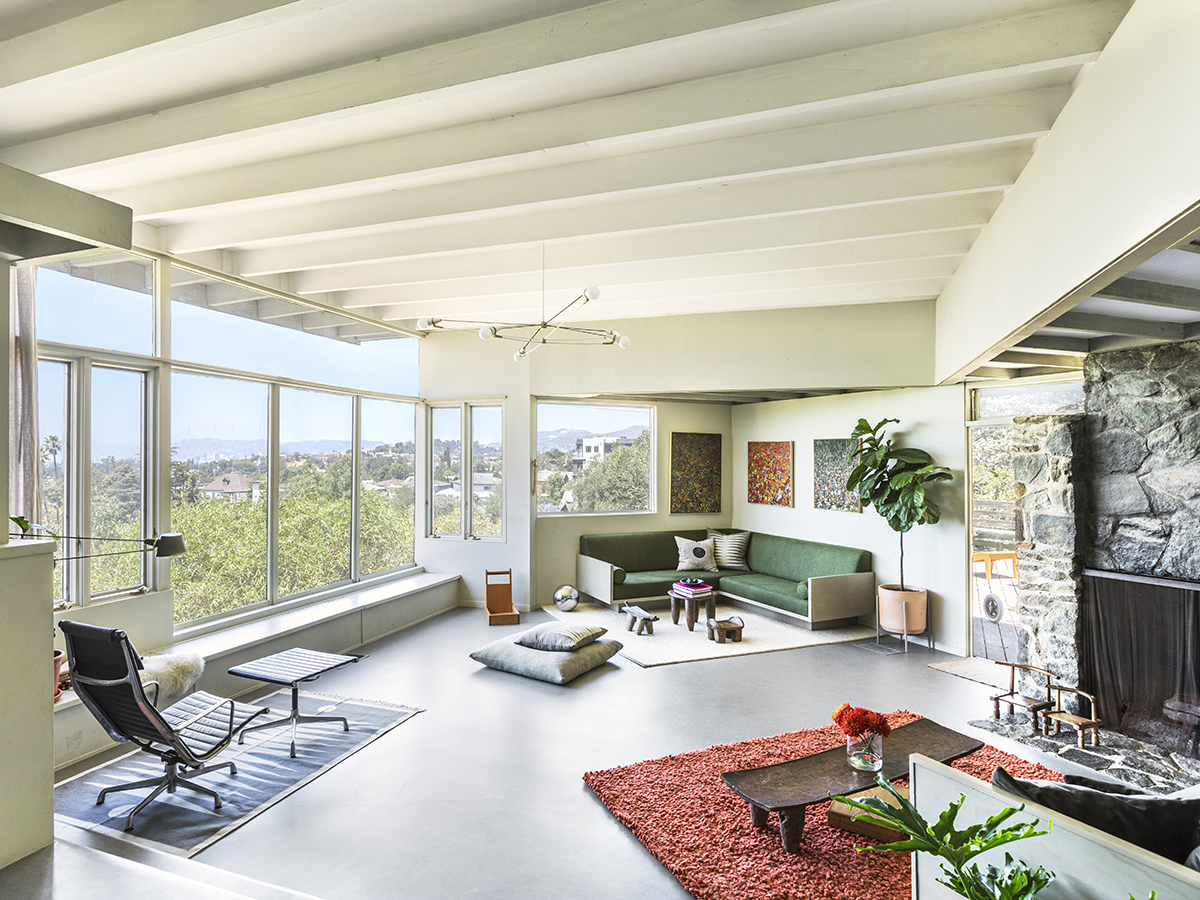
07.14.20
At Home With
How Brendan Ravenhill Ended Up Living In — And Restoring — a 1938 Schindler House in the Hills of Los Angeles
Brendan Ravenhill and his wife, Marjory Garrison, had been living in Echo Park for years before they realized that they were living around the corner from a gem of Modernist architecture. Built in 1938 by Rudolf Schindler, the Austrian architect whose volumetric residences dot Los Angeles, the Southall house, as it’s called, was hidden from street view and in a state of disrepair when it fell into Ravenhill’s lap in the mid-2010s. (We’ll save the juicy details of the story for below). Eight years and many historically appropriate renovations later, the house is as photographed here — a three-bedroom, two-bathroom respite from the city, carved into the landscape by Elysian Park, with balconies and floor-to-ceiling windows that provide views all the way from downtown to the Hollywood sign. Schindler designed the layout in a way that might follow the path of the sun throughout the day, which has educated Ravenhill and his family about one of the more revelatory facets of living inside one man’s vision — the quietly radical idea that a house might dictate the way you live. We recently spoke to Ravenhill about what he learned about the house’s original owner, why the walls are painted pistachio green, how Schindler used his $6000 budget with economy, and what it’s like to sensitively restore a piece of iconic architecture.
PHOTOS BY LAURE JOLIET
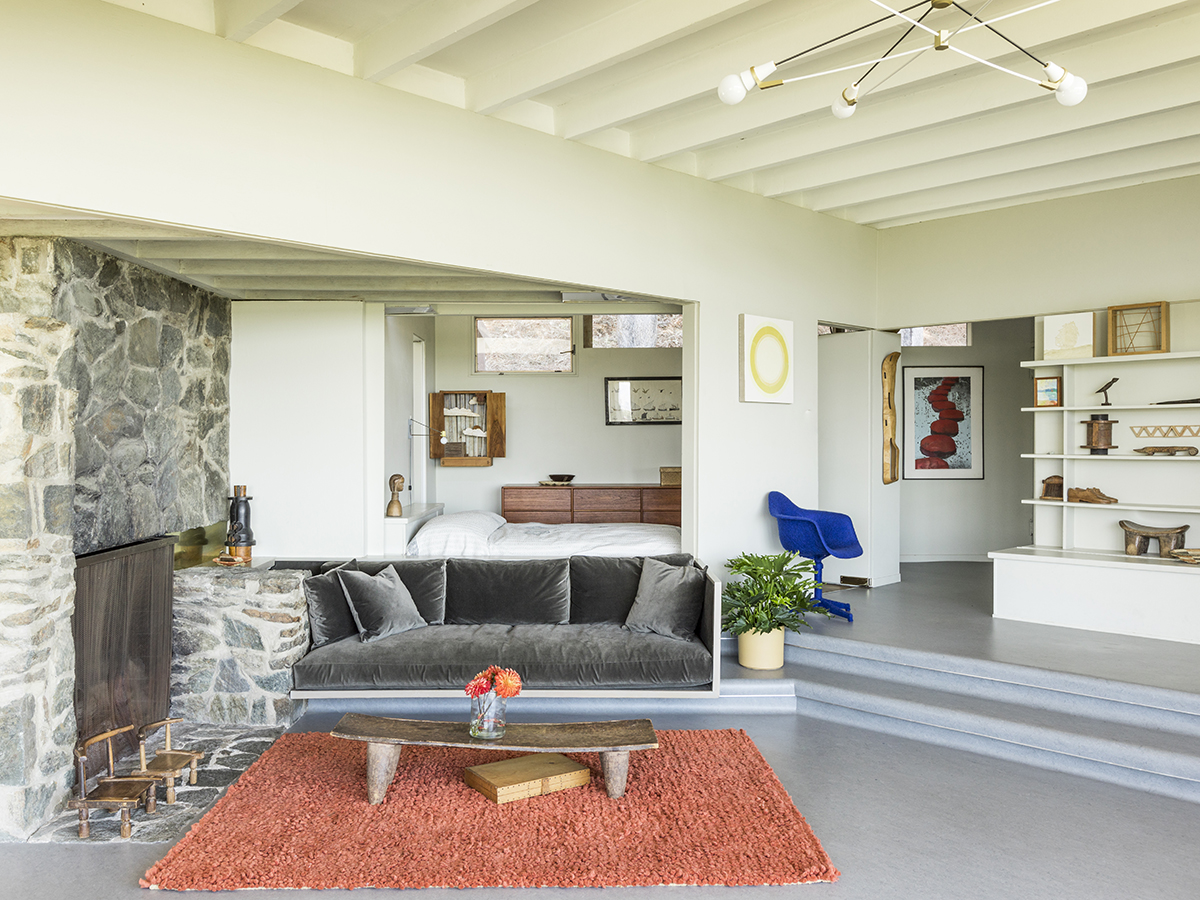
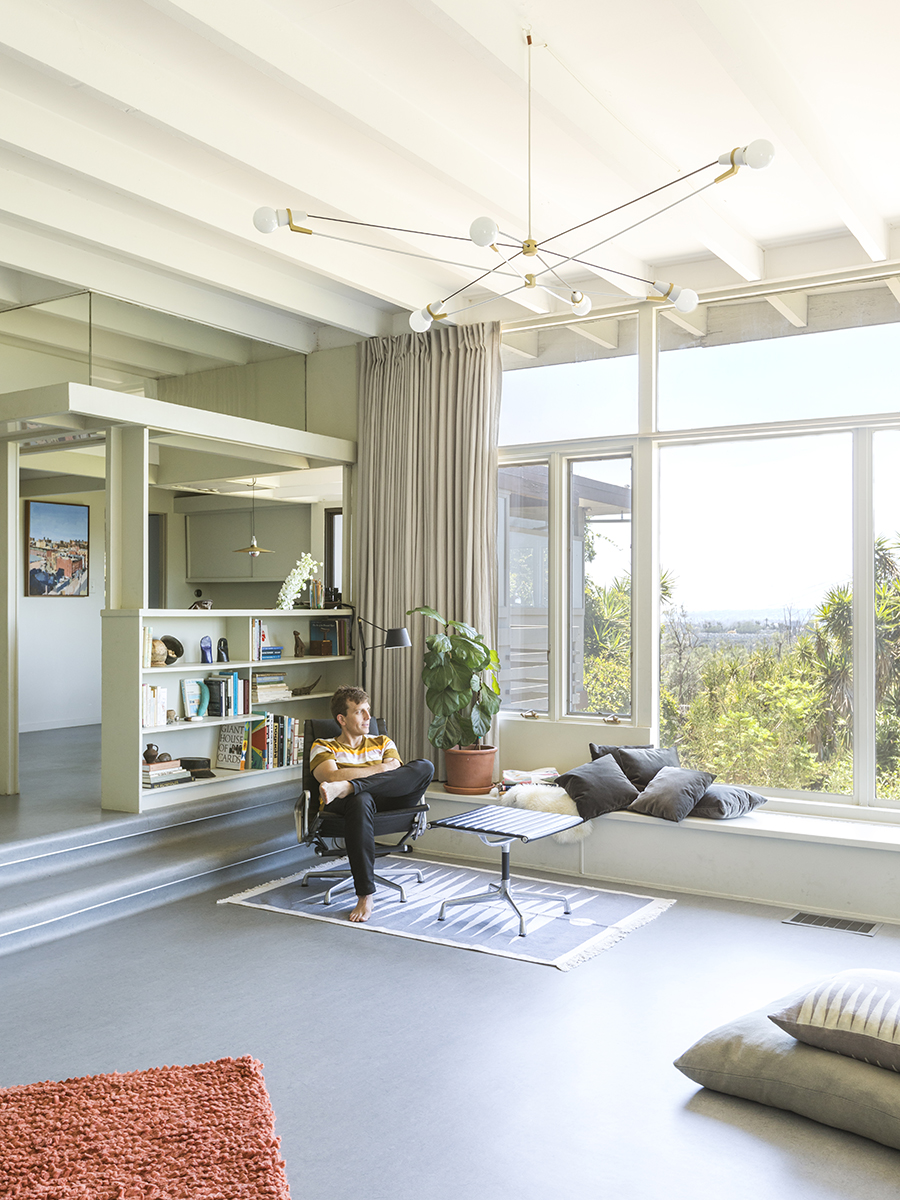
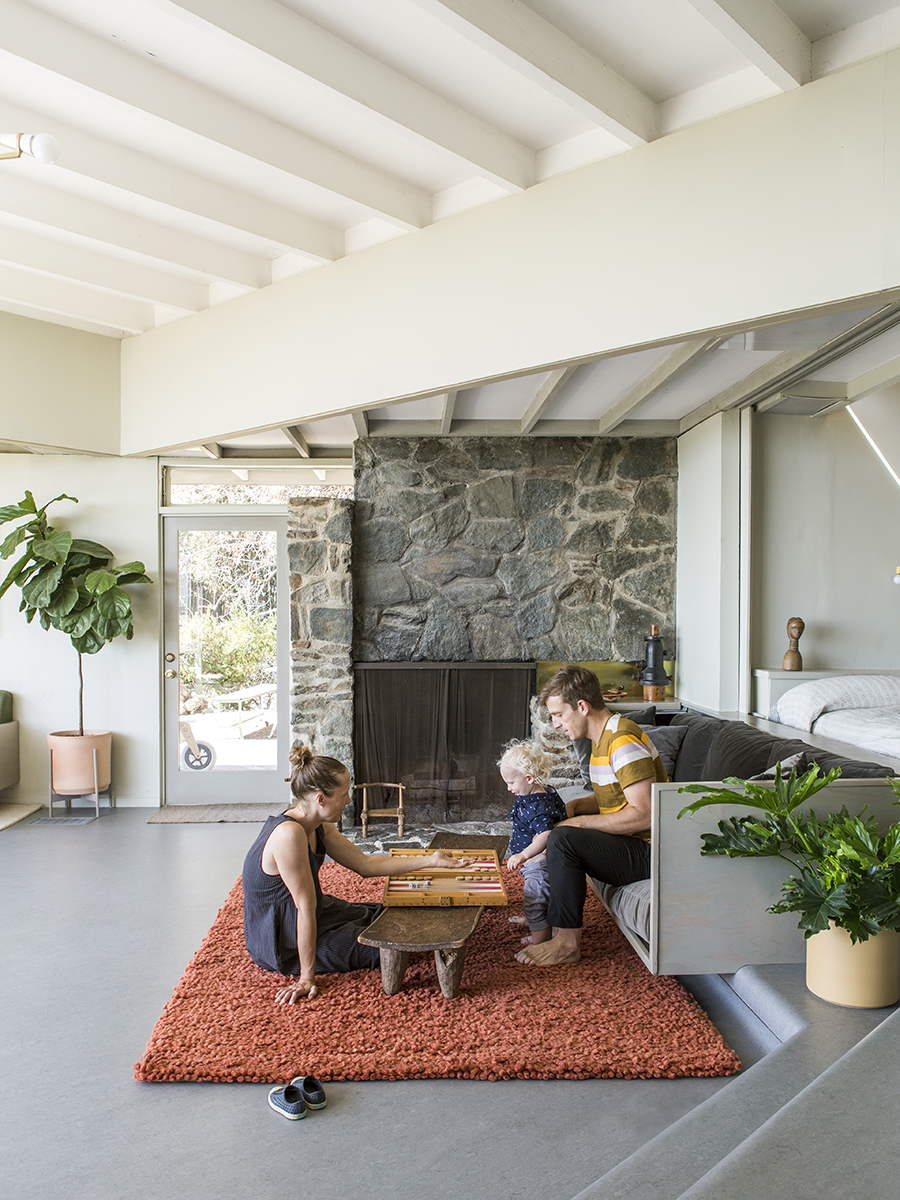
Tell me a little bit about your origin story with this house. How exactly did a 1938 Schindler come into your possession?
Well, I will say that when we first moved to LA, one of the first things we did was go to the Kings Road house and start getting involved with the MAK Center’s programming. Schindler was a theme throughout; I probably went to three or four of his houses for different events within the first year I was here.
At the time, my sister-in-law was dating a guy who owned an Airstream trailer, and who had this habit of finding places to park his Airstream for free. He was scouting around for a place to park in LA, and around the corner from the house my wife and I were living in, he saw an empty lot. He found the owner of the lot through a title search and wrote to her, introducing himself as a landscape architect who was looking to park his trailer, and inquiring if she had any interest in him parking on the lot and doing work to maintain the property. She replied saying, “That would be amazing, I just lost my husband. You’re welcome to park it up there — and, by the way, if you need to tap into any sort of utilities, you can just use the house, which is not really being inhabited.”
From the street, you can’t really see that there’s a house on the property; it just looks like a big empty lot. So he replied back saying, “Hey, that’s great, I didn’t realize there was a house, that makes it much easier.” And she’s like, “Oh yeah! There’s a 1938 Schindler on the property.”
So, basically, it fell into your lap.
Well, eventually the neighbors complained because they didn’t like having a big silver trailer on the lot, and the owner felt bad that she had to ask them to move the Airstream after all the work of getting it there, so she was like, “Why don’t you just move into the house and take care of it?” So my sister-in-law and her boyfriend lived in the house for about a year and a half, caretaking and living rent-free.
When they decided to move to the East Coast, the owner of the house had heard that my wife and I were looking to put down roots in the area, and she approached us about buying the house. We thought it was a great idea, but the house was way outside our price range, and it needed a lot of work. She was like, you don’t have to pay me a big deposit, you can try to rent to own, and you can get a land contract on the property — which is kind of an old-fashioned way of buying houses.
So we kind of threw caution to the wind, moved in when they moved out, and started the slow process of making it our own. For about two or three years, we had a handshake deal without clear and open title or even a contract to the property. But we loved the house and just started the process of restoring it. We signed a land contract about three years later and had that for two years before we eventually took a clause in the contract to buy her out. Over the last three years, we’ve renovated the whole house, taking on one project at a time. The house originally had Marmoleum floors throughout, and the owner had replaced those with shag carpet and white tile in the kitchen and dining room, so that was one our biggest projects — to bring back to life Schindler’s original vision of one monolithic surface carried throughout the main areas of the space.
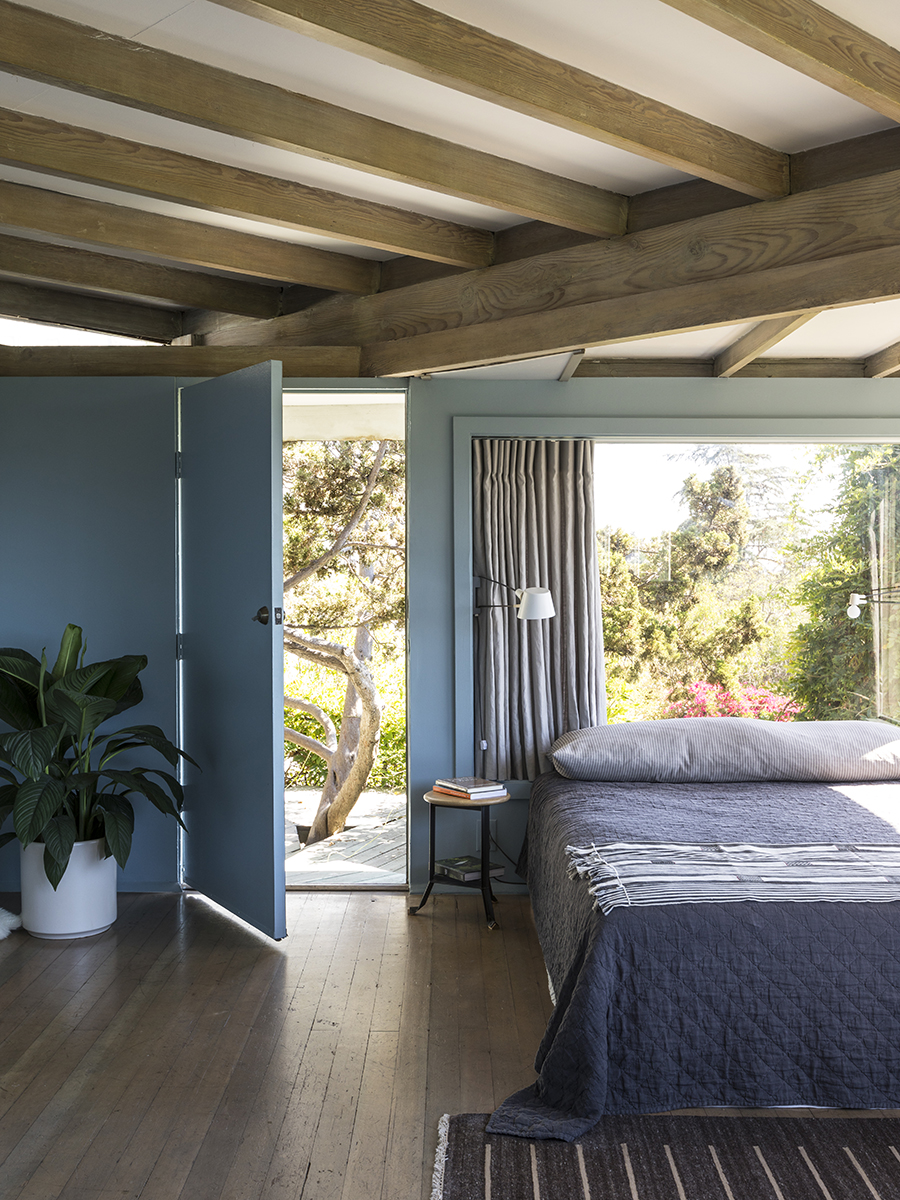
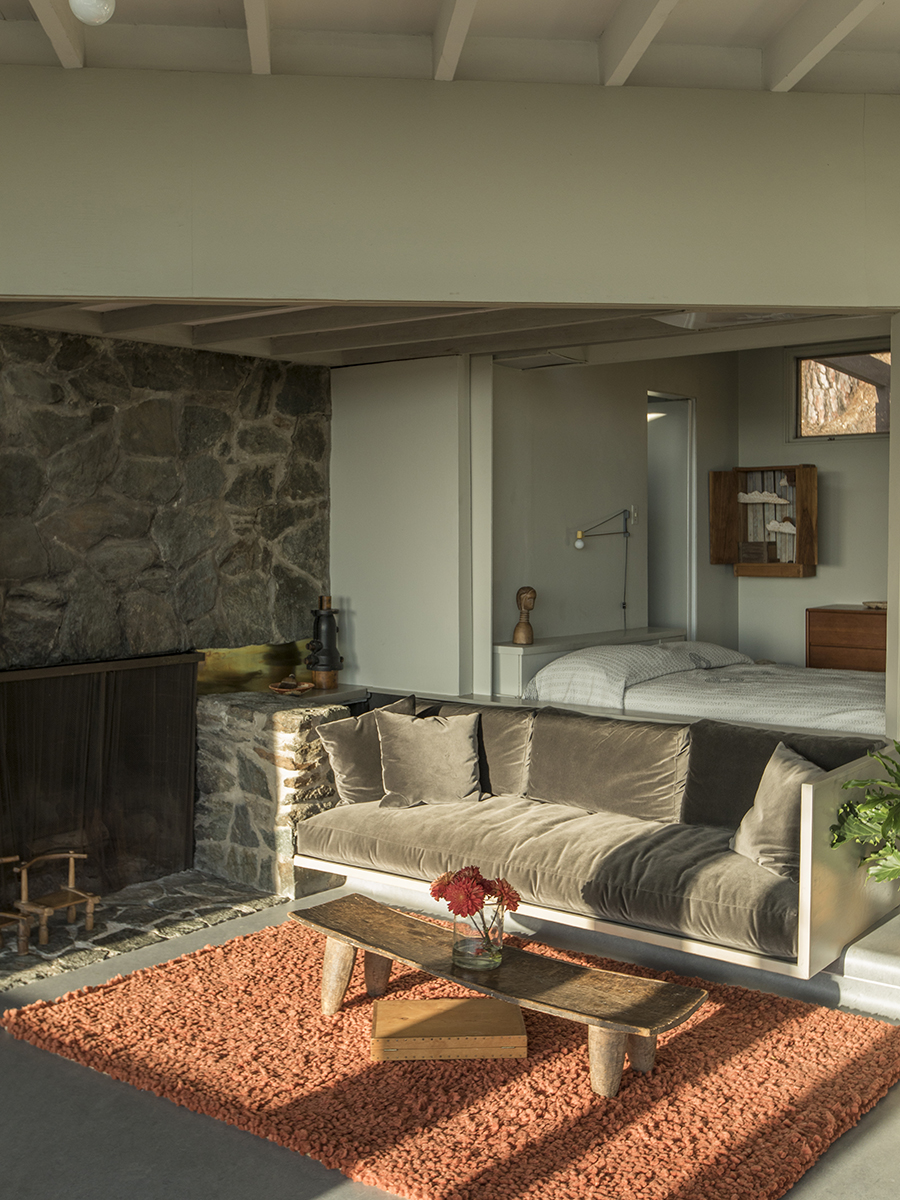
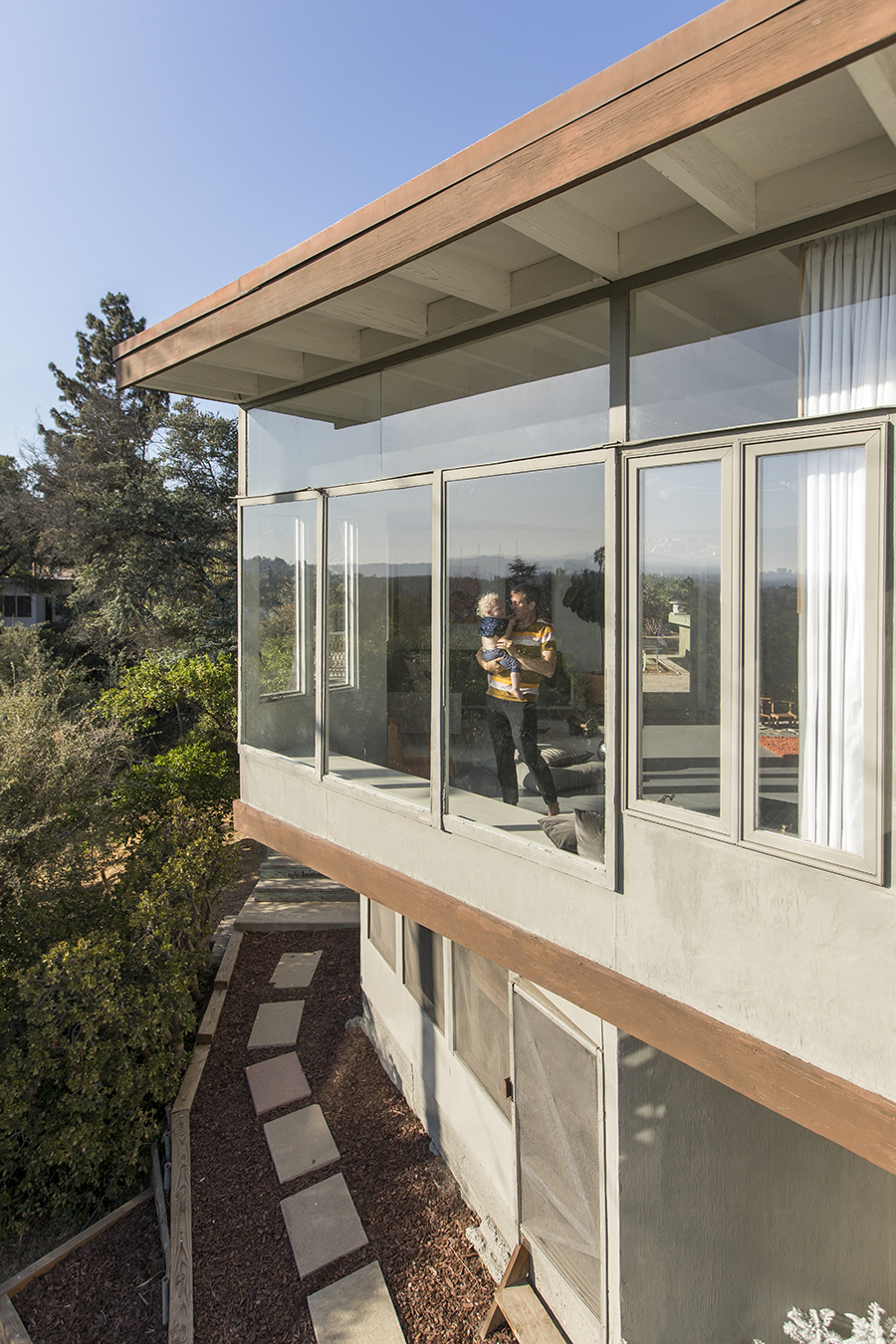
Let’s back up a bit. Can you tell me a little bit about the history of the house?
The house was built in 1938 for a woman named Mildred Southall. She was a music teacher and an Eastside intellectual — who basically taught piano to the kids of Schindler’s other clients — so the house was designed to also be a studio where she could run classes. Because the house was originally both a residence and a studio, it’s kind of divided into two halves, and there are two entrances. There’s an entrance to the private side of the house where her bedroom and a little nursery were, and there’s another entrance to the main part of the house, where the big, double-height living room is. We think Southall had synesthesia. In our research, we found that she wanted the whole house painted this particular shade of green, which to her echoed an E-minor chord. Her relationship to music was really a driving part of the design.
Schindler, at the time, was transitioning from his earlier De Stijl style to starting to think about volume in a slightly different way. The house is a sculpted series of rectangles that are oriented like an overlapping Venn diagram. There are three volumes: a living room where the pianos were, a dining/kitchen room, and then the bedroom. They all kind of overlap, and they all project out into the space at 45 degrees to the slope of the hill, so to speak.
Anyway, Schindler was building this house for, you know, a piano teacher, so the budget was incredibly small. I think the whole thing was built for $6,000, which even in 1938 was a pittance. It was his first all-plywood house. There’s a repeated grid of four feet that carries throughout the house, and all the studs and beams are spaced two feet apart, but it’s basically this undulating series of roofs that kind of drop down to almost seven feet in some places, and then grow in progression until they get to more like ten or twelve feet in the main living room space.
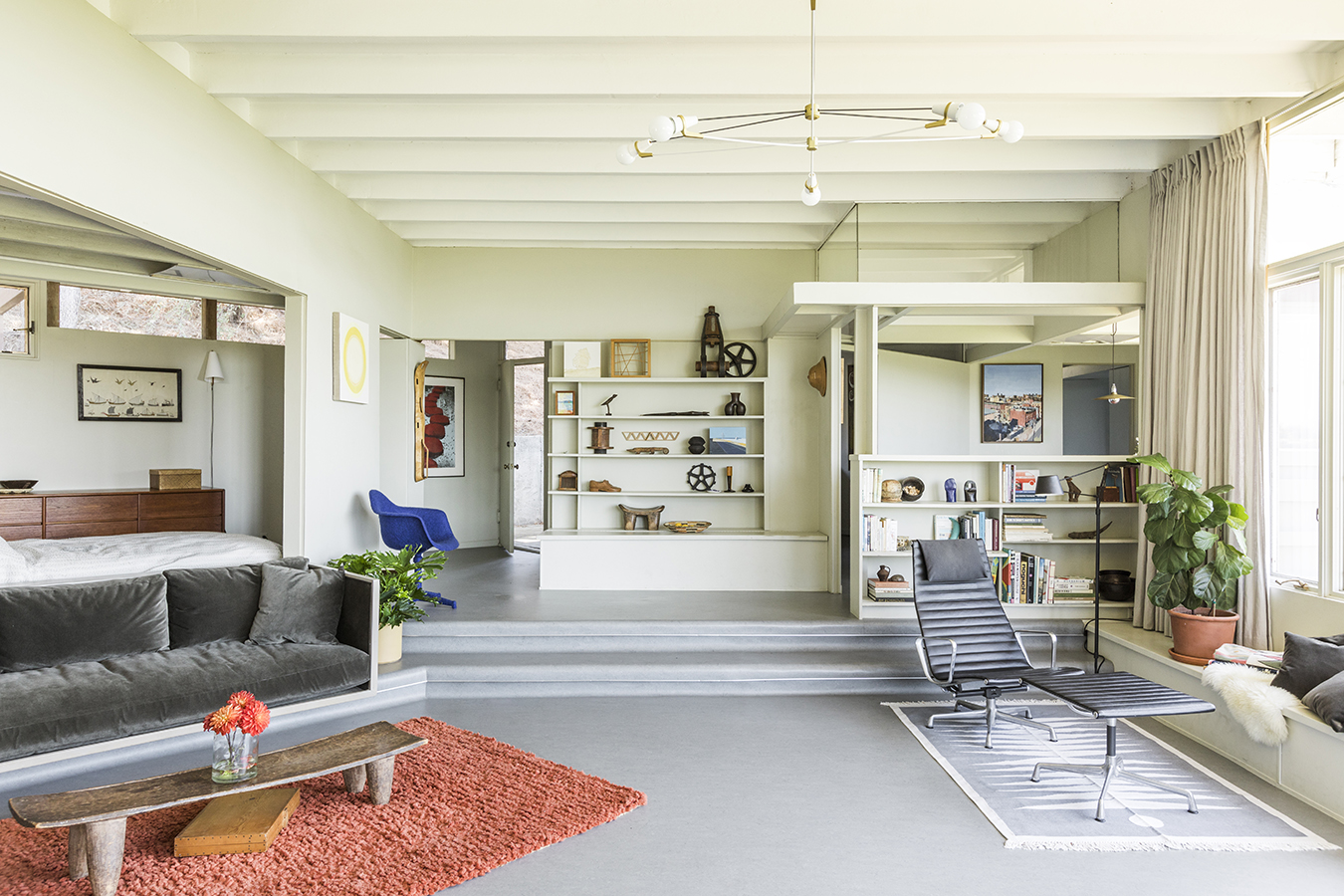
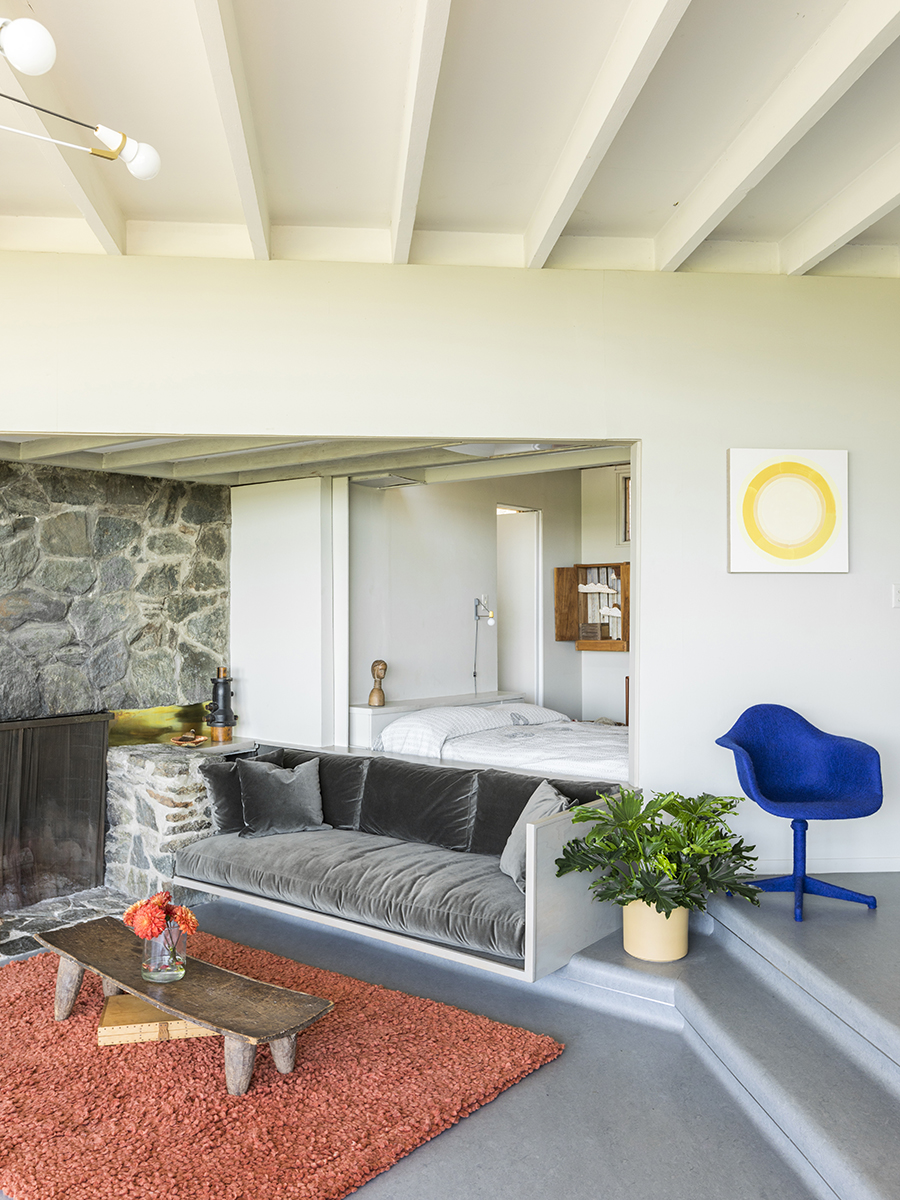
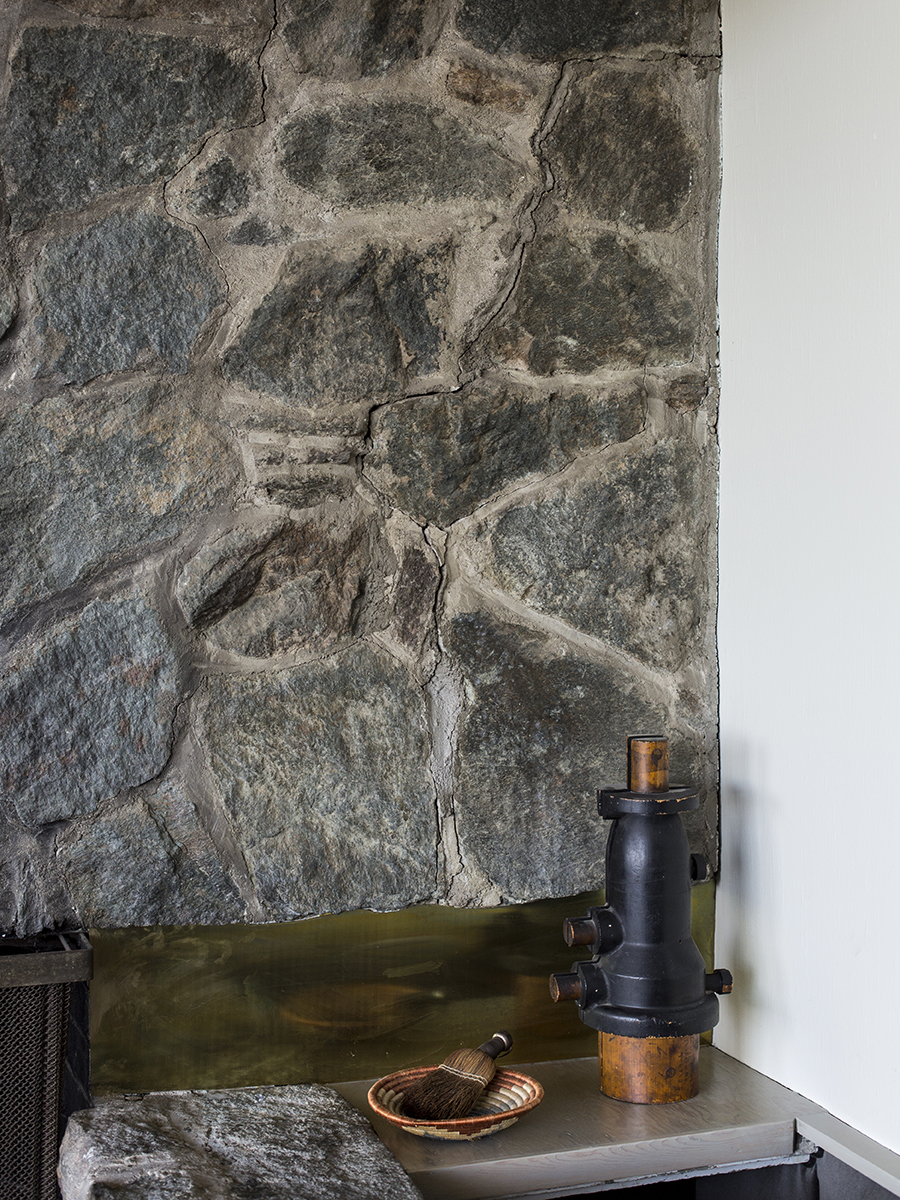
What was the condition of the house when you first saw it?
It was rundown. There were windows that had been painted shut that hadn’t been opened in many years. The floors were all in need of being redone, both of the bathrooms were kind of crumbling or falling apart, and in general we were fighting a rather large rodent infestation.
The big work we did was rebuilding both bathrooms in a style that was reminiscent of Schindler, tearing out the kitchen that the owner had built, and restoring the kitchen with a marine-grade plywood that was stained to match the original. We also did a fair amount of landscaping in and around the property, and we had to install heat and AC, so it’s been a long process to be able to take those on and afford those one by one.
All in all, she had not altered it to the point that was, you know, too far gone. It just took a lot of spit polish and paint to kind of bring it back
Was the woman you bought the house from related to Mildred Southall?
She was not. She bought it from the second owner, who had gotten it from Southall’s long-term partner. She bought it not knowing it was a Schindler house; she just loved it because she thought it had a very Japanese aesthetic, and she’s half Japanese. She raised her kids there and lived there for thirty-odd years, then moved to Mexico, so the house sat vacant until we came along.
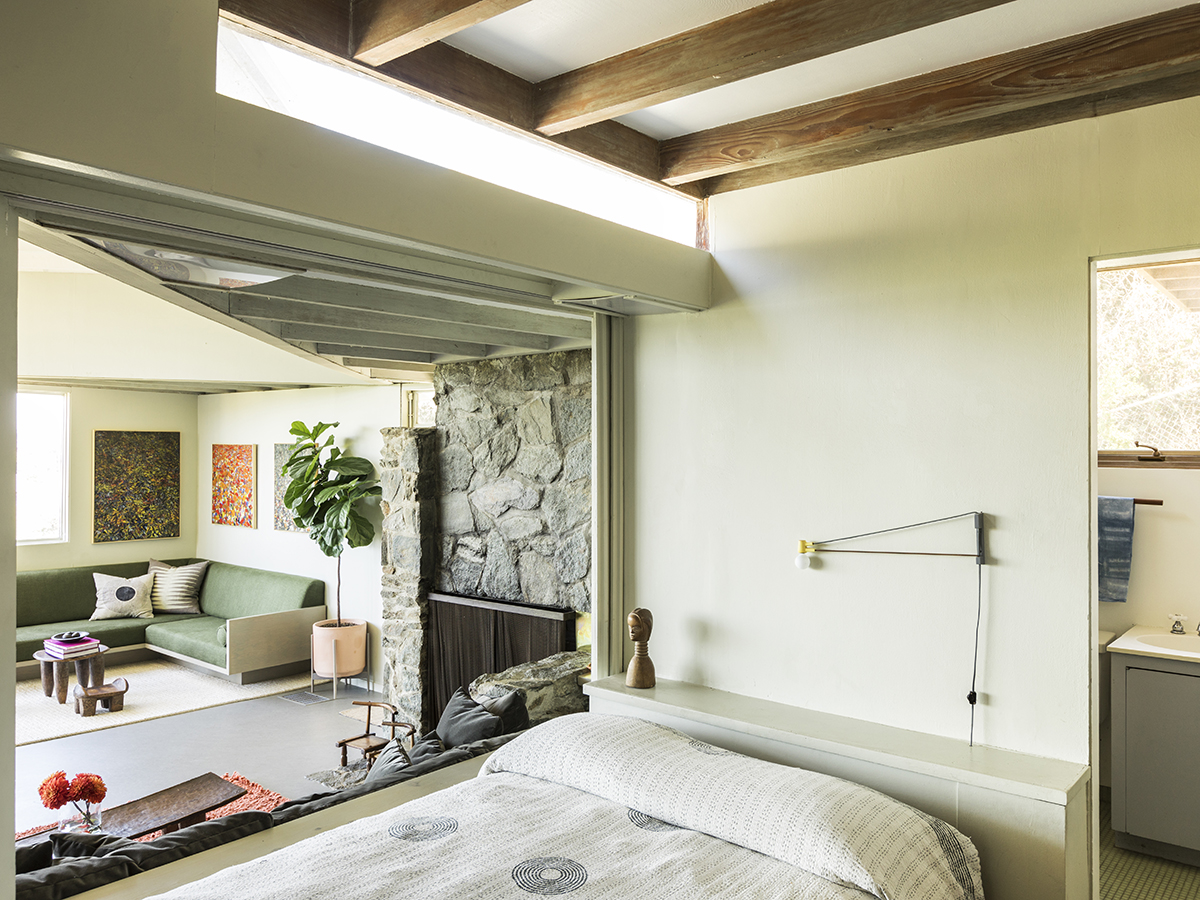
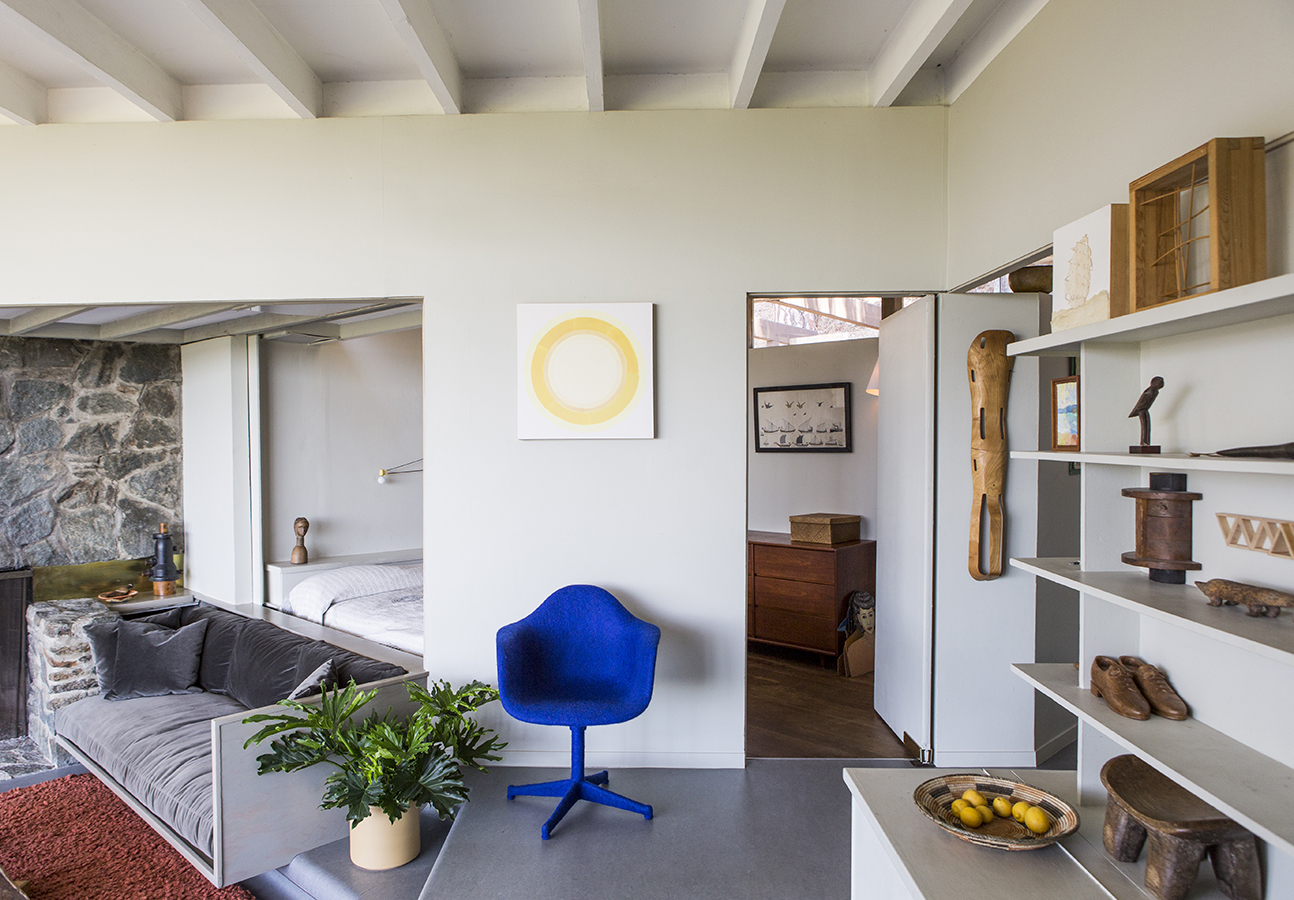
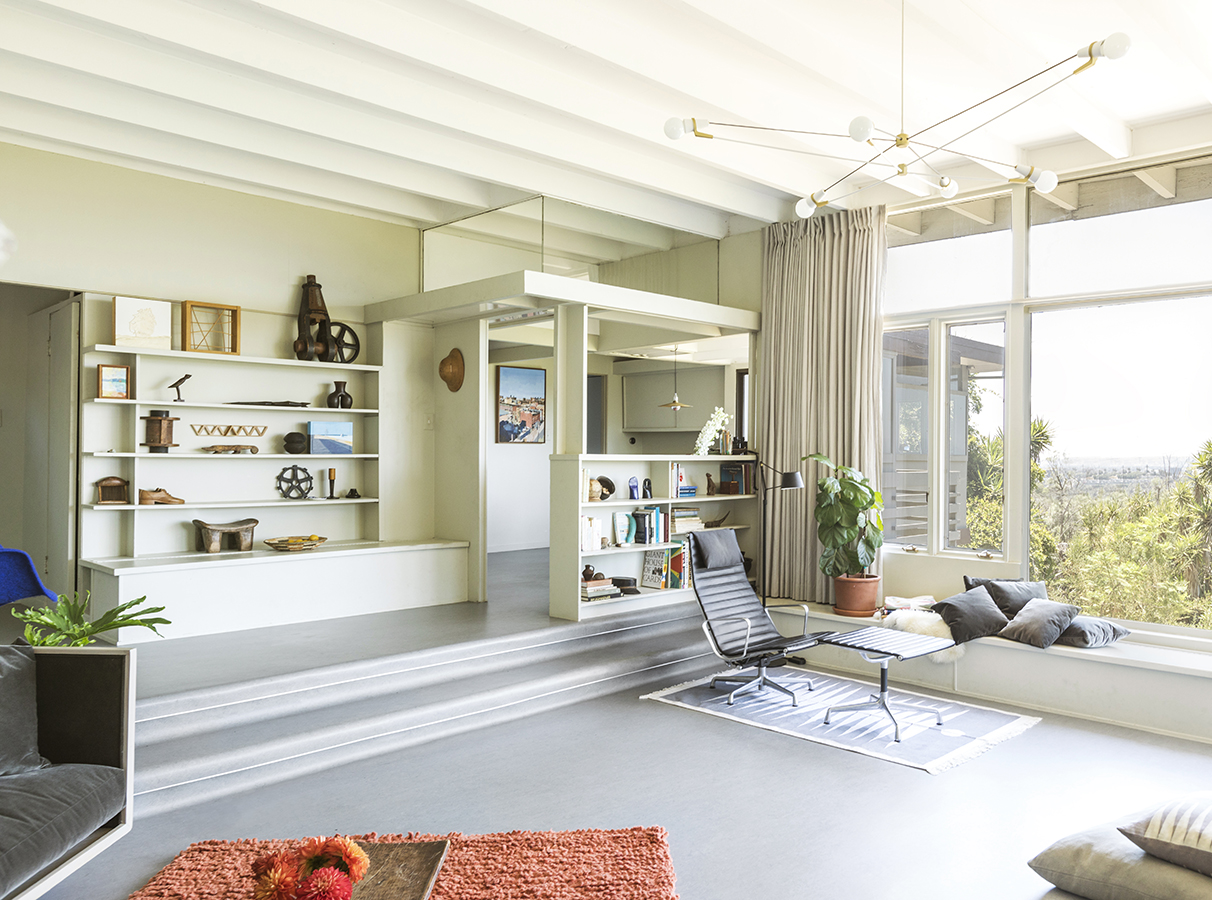
Can you take me through some of the rooms as if we were doing an actual house tour?
So the little room behind the built-in couch is actually the main bedroom, no bigger than 10×15 feet, and behind the couch are these sliding panels that close to provide privacy — though arguably just visible privacy, not acoustic privacy. But Schindler had a real ability to transform a space — this is a teeny bedroom with a teeny bathroom attached to it, but it has these grand, grand views, because from the bed you can look out and see the lights of LA, and you’re on this slightly elevated perch with the living room kind of spilling out below you.
Was that built-in couch original?
It was original, but we restored it. We tried to find upholstery that was close to the original, as much as we could tell from images. We ended up doing a velvet finish on the couch and rebuilding the casement and re-staining it because it had been painted over the years.
Did you bring most of the other furniture in, or did you buy things after the fact because they felt of a piece with the home?
A large part of our collection is actually stuff that my parents collected in West Africa. My dad was a museum curator at the National Museum of African Art, and I was actually born and raised in Côte d’Ivoire until I was eight, so there’s a smattering of furniture that I inherited from him and that’s a lot of what you see in the pictures. The other things are just things that we have collected — the blue chair is by Tanya Aguiniga. It was kind of a motley Eames chair that I dragged around for many years, and it was pretty worn and beat, and Tanya was kind enough to felt it. I have this habit where I try to collect one piece of design every year for my own personal collection, so there’s also an Eames splint I acquired a couple of years ago from JF Chen.
At some point in the process, we got our friend Sally Breer involved. She came over for a consultation and had this really wonderful eye about what to do. She encouraged us to replace our vintage couch with one that would reference the original built-in one but do so in a way that wasn’t a one-to-one copy. So the green couch and the original built-in are opposing couches — you sit on them depending on the time of day. The built-in is really great for evenings, when the sun has set and isn’t blaring on you, whereas the green couch in the corner is the one you go to in the middle of the day. The lounge chair on top of the Block Shop rug is a favorite place at night to read a book.
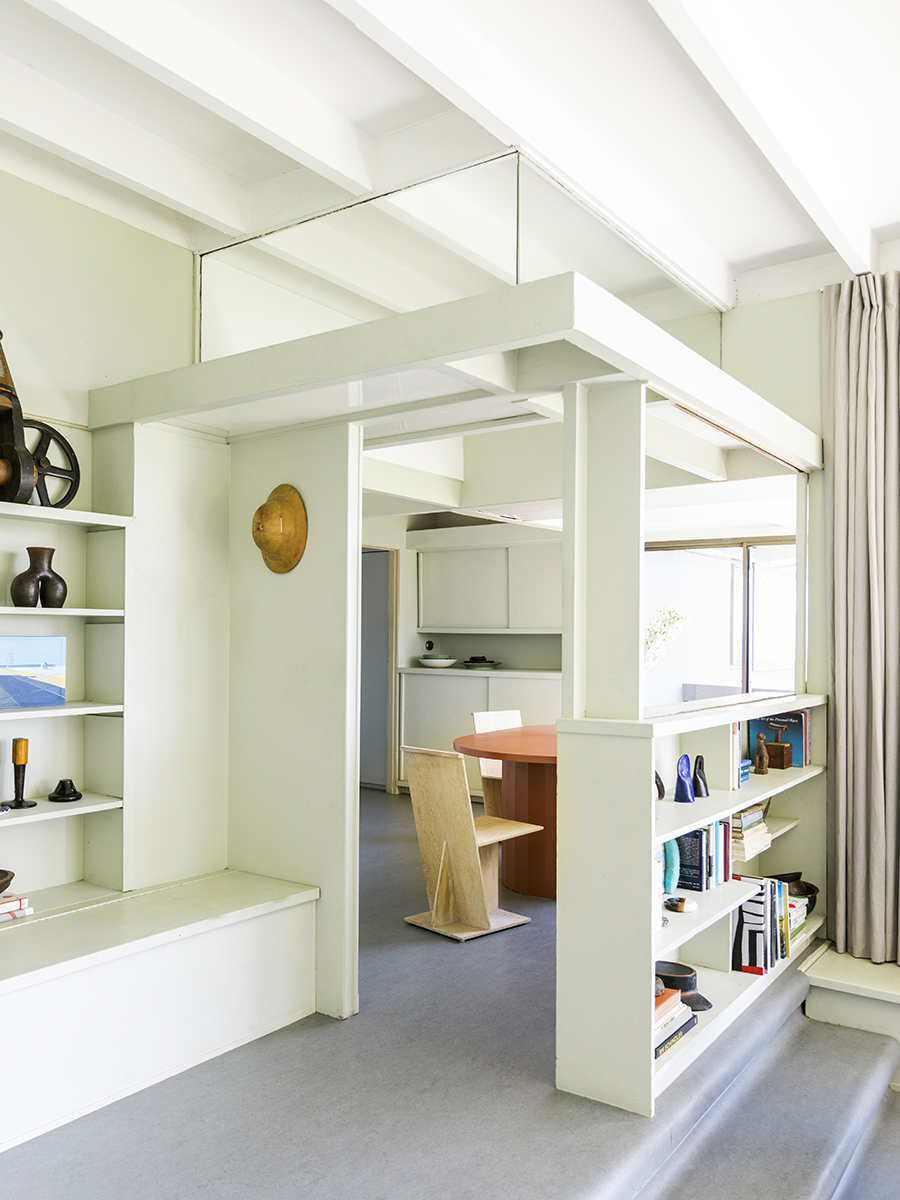
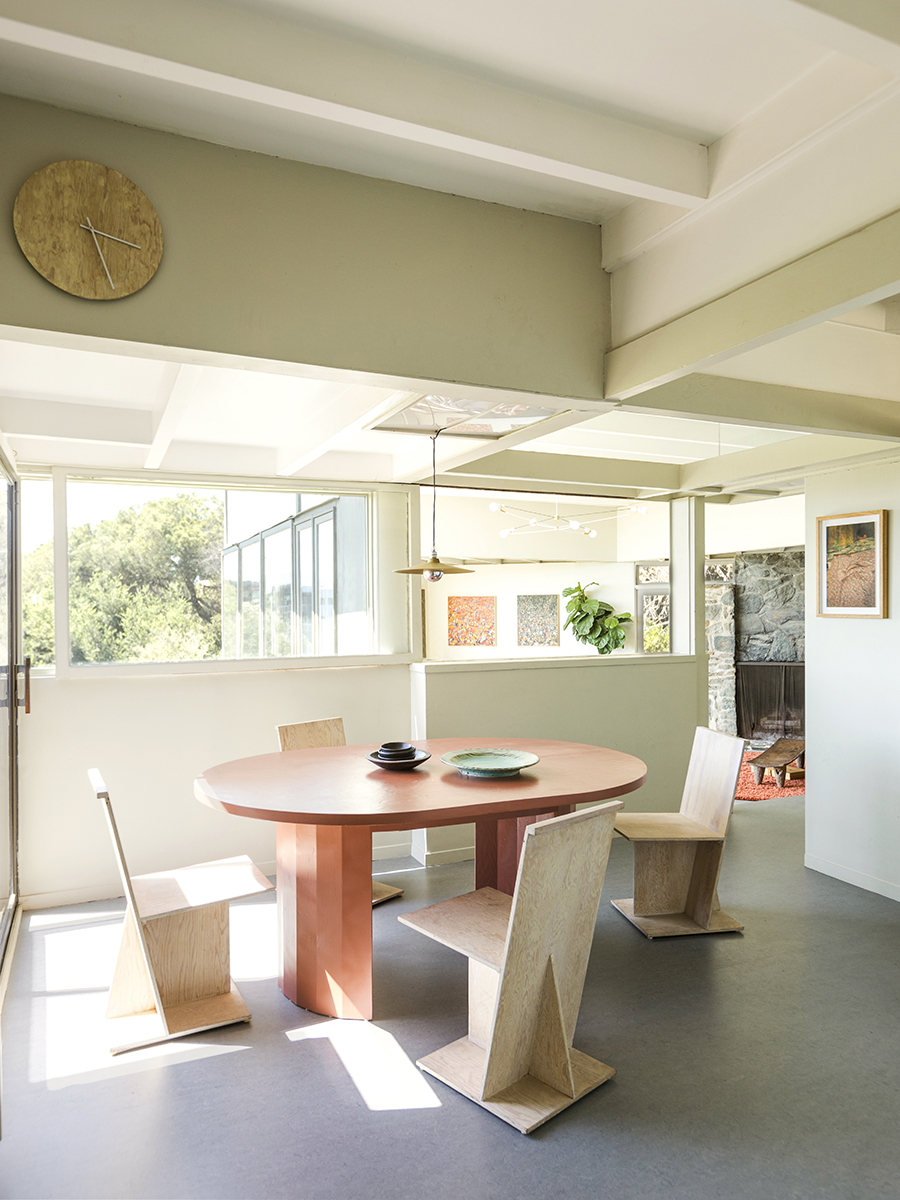
The dining room is kind of the most overtly Schindler-y part of the house, with those replicas of his dining chairs.
Our Church family of lighting was inspired by Schindler and built for his Bethlehem Baptist Church, so when we were photographing the lights for our website, we recreated these chairs as part of the set dressing. A friend of mine out here in LA, Brendan Sowersby from 100xbtr, had some of these chairs that he’d made from an original he found in a neighboring shop, so he had really accurate drawings. He was kind enough to cut us some of the parts in plywood. Luckily, I ended up benefiting from them, so we have four of them here.
They’re pictured underneath a clock which is actually a piece of plywood that I salvaged from the original bathroom. Originally, Schindler had made all the walls of the bathroom out of quarter-inch plywood that he stained yellow. The plywood didn’t hold up long term, but when we restored the bathroom, we found layers of it sealed behind tile. I ended up salvaging a bunch of it, and made that clock as a present for Marjory for our anniversary.
The dining table is another prop that was just kind of sitting around our studio. It had been stained a different color, and Sally suggested painting it this beautiful terracotta color. So that’s two different pieces of our set furniture. We often have these things hanging around the studio, which has been great, and I just ended up taking a handful of them home.
My other favorite room is the bathroom.
The tile in the bathroom is green mosaic tile from Marsala. It was inspired by visiting Schindler’s Leland Fitzpatrick house, where he employed this kind of 1×1 mosaic tile, so we copied that.
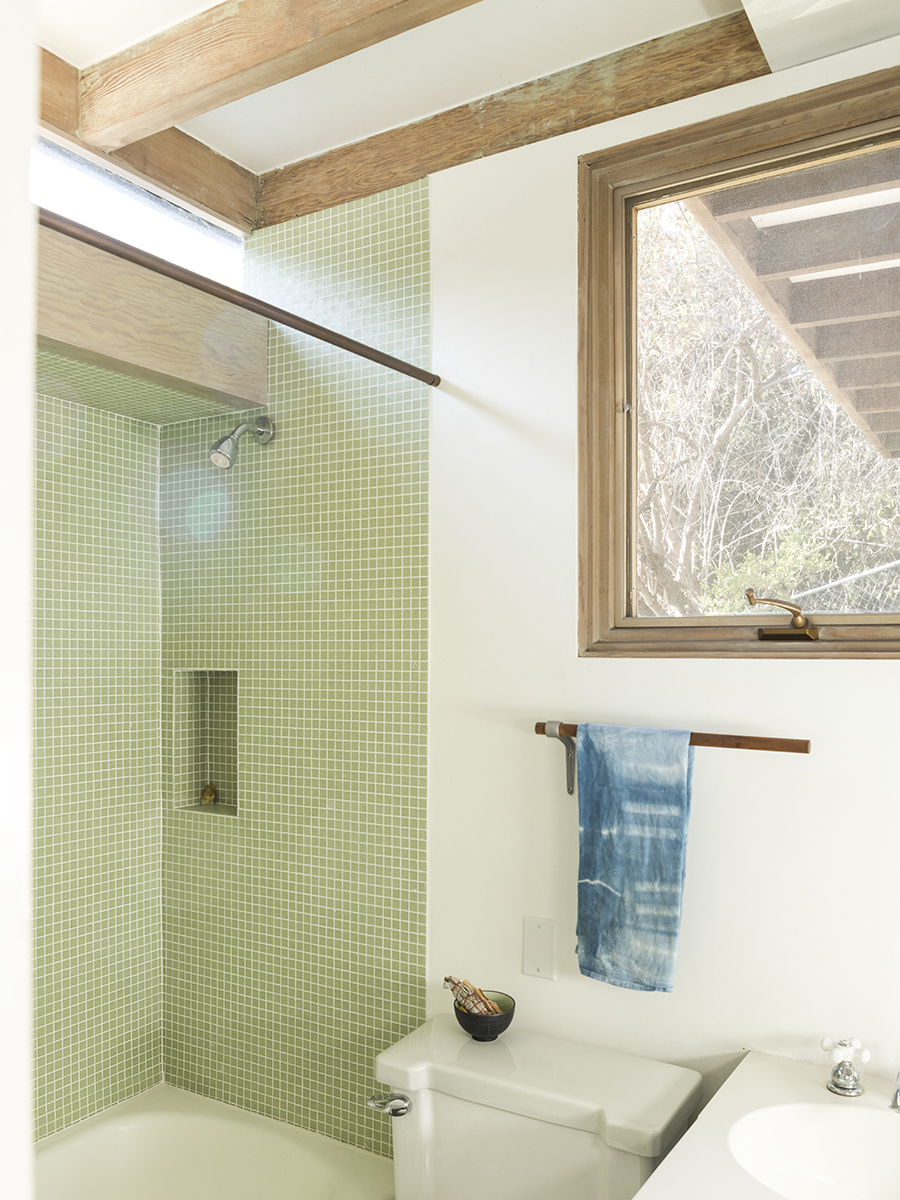
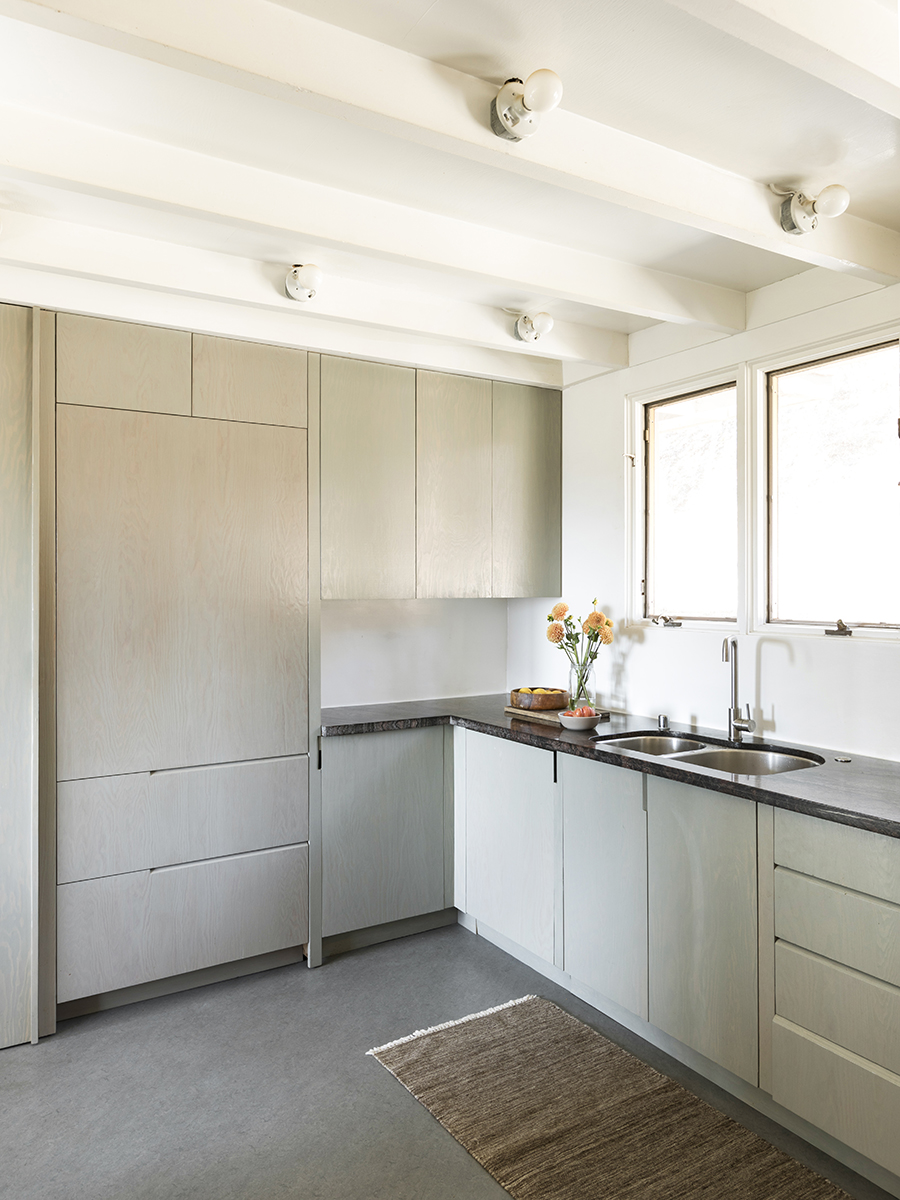
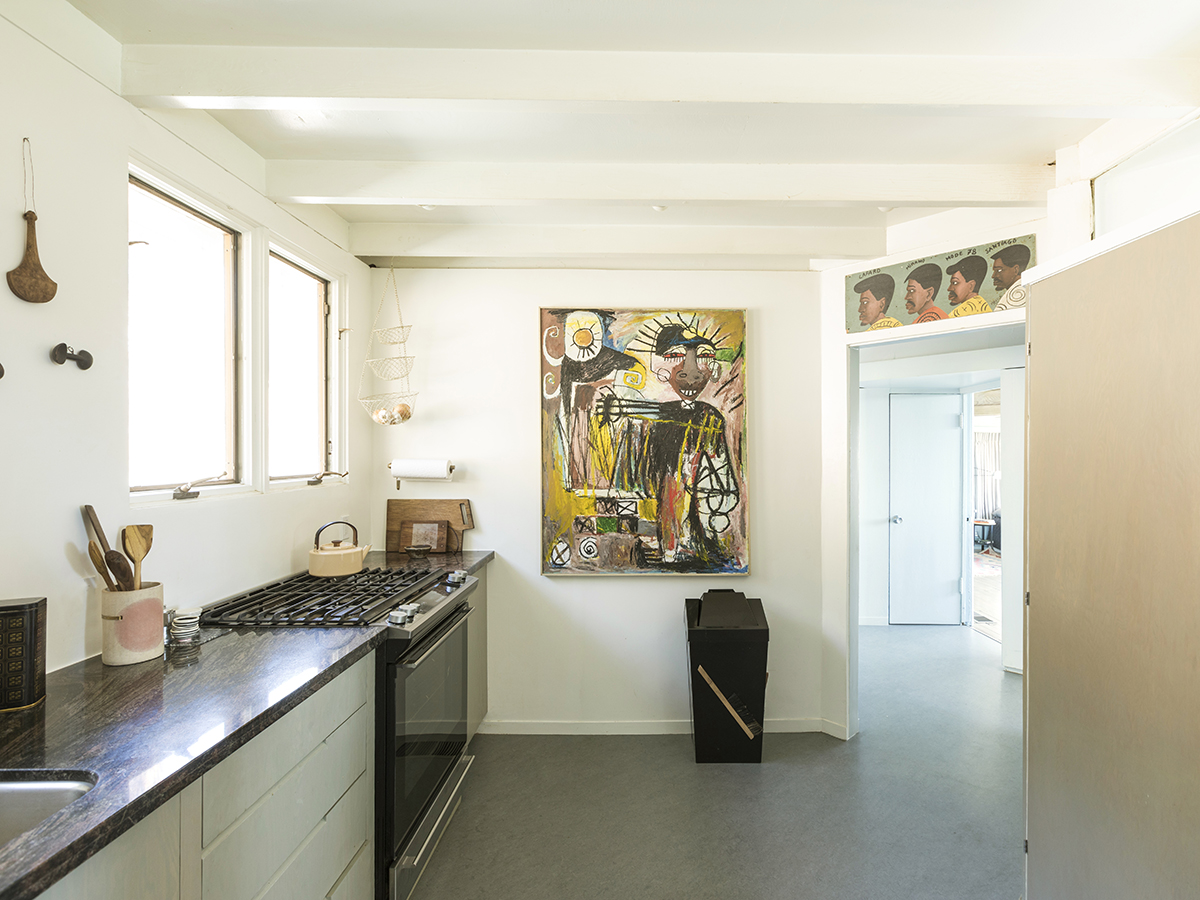
Were the original interior photos you found of the house in color?
The original pictures were, for the most part, in black and white. There was one color image that we did find in an old magazine printed in 1944, and we were able to infer a lot from that color image. For example, in the fireplace picture, there’s a piece of brass that’s sitting behind that sandcasting mold that had long ago gone missing. When we saw that image, we were able to match the detail from that image and restore it.
What is it about Schindler and this kind of midcentury aesthetic that appeals to you in general?
Living in a Schindler house for me is a constant reminder that you don’t need to spend a lot of money to have a huge impact — that even simple materials like sheets of plywood can be used in novel and new ways through their use and orientation. I think that’s always something that really inspires me as a designer. It’s not about the most fancy materials — it’s about the considered use of materials.
I also think this house dictates a certain way to live. We’ve now put curtains up in the main space to create a little shelter because we have a three-year-old, but for a long time the house would push us out in the middle of the day because it would heat up too fast, and it would encourage us to come back at sunset when the house had cooled down. It’s a big house, but it doesn’t prize size in the bathrooms or in the bedrooms. It puts the size in the living rooms, and that encourages you to spend time together. The way the house programs your existence has been a fun thing to realize.
I think it’s just a really inspiring period in general. All of these ideas were still so new — the way he could use these materials to create a sculptural space full of so many little details, but do so in a way that didn’t require a thousand different construction drawings… We have notes that we found from his archive, from Southall to Schindler, saying: “The contractor said that you’re there more days than he is.” Schindler was such a hands-on designer, and his attention and his sensitivity and his presence can really be felt in this house.

